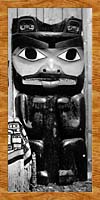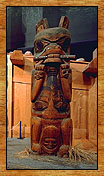 Housefront Housefront
 Paintings Paintings
 Carved Interior Carved Interior
 Poles and Posts Poles and Posts
 Interior Screens, Interior Screens,
 Housepits, and Housepits, and
 Smokeholes Smokeholes
 |
Carved Interior Poles and Posts
The oldest form of interior carved crest poles in Haida houses was probably the pair of matched posts that stood at the back wall under the central beams. Frequently, there was but a single crest figure on each of these posts, such as a Bear, Whale, Raven, Sea Lion or human, though in some houses, like that of Chief Skowl at Kasaan, all four support posts are elaborately carved. These carved house posts are typical of both Tlingit and Tsimshian houses and were probably the prototype for the carved interior central poles favoured by many Haida chiefs. Their placement at the centre of the house under the peak of the roof allowed them to be up to 5.5 m (18 feet) tall, as in Chief Skidegate's house. The carved interior central pole was usually a complicated sculpture based on a founding myth of the family. Amos Russ and Tom Stevens, two chiefs of Skidegate, provided John R. Swanton with different interpretations of a nineteenth-century pole carved by Charles Edenshaw. Boas comments on the variability of interpretation as follows:
Swanton . . . had two informants; both explained the top figure as an eagle but they differed as to the meaning of the rest. The one claimed that the lower part of the pole represented the story of a woman being carried away by a killer-whale. The woman's face shows just below the eagle's beak, and the whale's blow-hole is represented by a small face above the face of the killer-whale. The second informant, however, explained the large face at the bottom as that of a grizzly bear, presumably meaning thereby the sea-grizzly bear; and the small figure over it as the "sea ghost" which usually rides upon its back. The woman's face he left unexplained.
. . . Obviously in this case the symbolism is not clear enough to enable an Indian who does not know the artist or who does not know the meaning of the carving to interpret it correctly.

 |
An interior house post from Grizzly Bear House, which belonged to Chief Xa'na of Masset. Now in the Dahlem Museum, Berlin.
Photography by Richard Maynard, 1884.
CMC 100462 |

One exquisite house model from Masset is a relatively authentic portrayal of Chief Wiah's Na Yuans (or Monster House), carved for the missionary Thomas Deasey. As the historical photos show, that house did indeed have carved corner posts, as well as a large frontal pole depicting the flood story of Qingi, whose large bearlike figure sits atop both the model pole and the real pole. The Eagle, a crest of Wiah's, takes flight from Qingi's head in both versions.
The actual interior central pole from Chief Wiah's Monster House now stands in front of the Haida house in the Grand Hall of the Canadian Museum of Civilization. It portrays a standing Beaver gnawing a stick inlaid with over a hundred pieces of abalone shell. The nostrils of the Beaver also have abalone inlay, and its paws and tail have small faces on them. On its head are six skil-daden (or potlatch rings), a feature frequently associated with the Beaver. A similar carving stood outside of Wiah's house but sported a much larger stack of nine potlatch rings. Both versions, the one for external display and the other for display inside the house, were undoubtedly created by the same artist. The Beaver crest was given to Chief Wiah by Chief Legaic of Fort Simpson, who had a similar pole with thirteen potlatch rings standing in front of his house. The crest's origin goes back to the supernatural beavers who lived at Kitselas Canyon on the Skeena River.

 |
From stylistic evidence, this Sea Lion house post (one of a pair), 9 feet (2.7 m) high, came from an old house in Howkan village in Alaska. They appear to have been repainted by a native artist just before they were sold.
Acquired by George T. Emmons for the Lord Bossom collection.
CMC VII-B-1810a (S94-6760) |

 |
An interior house pole of Chief Wiah, displaying his crest of a standing Beaver with a Sculpin on its belly. The Beaver is gnawing a stick inlaid with nearly one hundred pieces of abalone shell. This pole was probably carved when the house was constructed circa 1850. It now stands before the Haida house in the Grand Hall of the Canadian Museum of Civilization.
Acquired from Chief Henry Wiah of Masset in 1901 by Charles F. Newcombe.
CMC VII-B-1130 (S92-4407) |

On both versions of the pole, there is a large face that appears to consist of a series of six sculpted portions, which I now believe represents the segmented body of a Dragonfly, although I earlier identified it as a Sculpin. The two crests are often portrayed as alternates of each other. This truly remarkable sculpture is the only item that was saved from Monster House, the largest dwelling on Haida Gwaii, thanks to the prompt efforts of Charles F. Newcombe as the house and poles were being cut up and burned early this century.
|